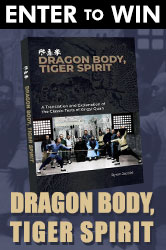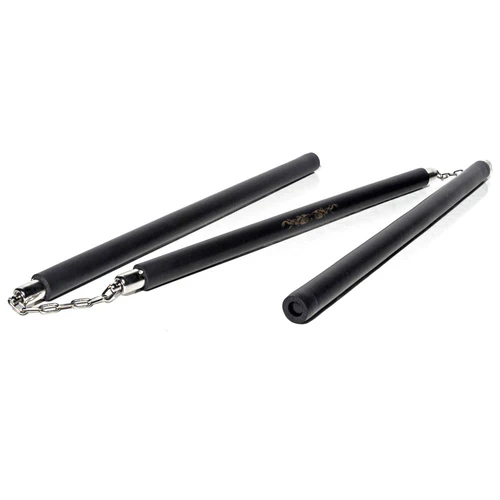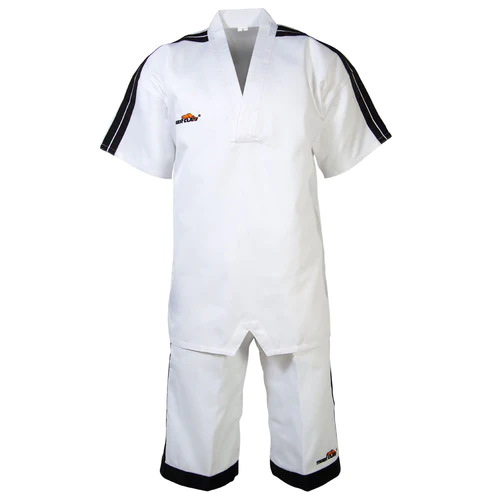 Everything in this world has a nomenclature issue. Every specific branch of learning has denotations and connotations along with corresponding terminology, whose accuracy reflects to a certain degree the maturity of the branch's development. Therefore, every branch of learning is faced with the issue of "name rectification." Wushu is no exception. Wushu has always been admired for its deep roots and voluminous content, but it is experiencing a developmental stage that, due to its many sectors, has become a mess of terminology. The fact that it has largely been taught orally with all kinds of local dialects introduces even more variation. This lack of a systematic way of naming gives us the impression of a whole lot of disarray. Even today this situation is looming in the great land of America. Hence, Wushu is much in need of "name rectification."
Everything in this world has a nomenclature issue. Every specific branch of learning has denotations and connotations along with corresponding terminology, whose accuracy reflects to a certain degree the maturity of the branch's development. Therefore, every branch of learning is faced with the issue of "name rectification." Wushu is no exception. Wushu has always been admired for its deep roots and voluminous content, but it is experiencing a developmental stage that, due to its many sectors, has become a mess of terminology. The fact that it has largely been taught orally with all kinds of local dialects introduces even more variation. This lack of a systematic way of naming gives us the impression of a whole lot of disarray. Even today this situation is looming in the great land of America. Hence, Wushu is much in need of "name rectification."
In ancient times, the idea of "name rectification" was introduced in China. Its literal meaning is analyzing and defining a name or term. Confucius first suggested it in the Chunqiu Period about twenty some hundred years ago. In his dialog Zilu, there is a teaching: "Without proper naming, communication would be less effective; without effective communication, things could not be accomplished." Confucius's concept of "name rectification" had a specific meaning in a historical context and, of course, may not be something for us to follow. Still, in a modern society, especially in this information age, having a universal name for a subject is very important. For sport, which has now become a common language of international society, there is more need for the unification of its terminology. So, international sports circles have not only discussed the unified sports terminology, but also published multi-language dictionaries of unified sports terms. In China, Wushu is seen as an ancient sport, while for the rest of the world it's still a young one. Only recently did it step onto the international stage. So, we need to standardize and unify Wushu's terminology, starting with the term "Wushu" itself.
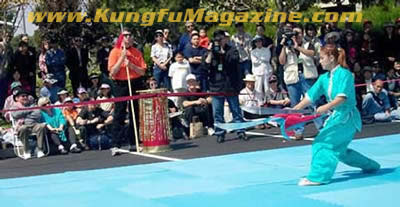
Wushu originated in China but now belongs to the whole world. In formal international competition, Wushu is presented in two basic forms: performance routine and free-style attack technique. When examined in a cultural perspective, taking into account how it embraces the fields of ancient Chinese philosophy, aesthetics and medicine, Wushu is a sophisticated multilateral science of considerable content. Wushu is not limited to specific boxing techniques but embodies a vast area of human activities.
When it first came to the world with its grace and appeal, Wushu, as the unified term, was utilized by the International Wushu Organization. In 1985, when the preparation committee for International Wushu Association was established in the ancient Chinese city Xi'an, the term used in its draft policy was Wushu; but in all the other languages, a direct transliteration of the Chinese word was used instead of a fully descriptive term. This term represents the unique style and nature of Wushu sport, in contrast to other fighting sports in the world. At that time, attending representatives from 16 countries and regions agreed unanimously to use this term and put it in the history of international Wushu movement. Preparing for the European Wushu Organization, the representatives from European countries at the same time also declared unanimously to replace its original draft term kung fu with the final term Wushu. Consequently, in November of that year, the European Wushu Association was established in Paris, using the final term Wushu. Since then, the Asian, South American, African and American Wushu Associations have all used the name Wushu. The competitions hosted by the international and all continental Wushu associations have uniformly used the term Wushu. In 1988, the Olympic Committee of Asia (OCA) decided to include Wushu as a formal competition entry of the 11th Asian Olympic Game, whereupon the word Wushu became the official term in the Asian Olympic movement.

Of course, the use of the term Wushu is still not unified and wide-spread. On the one hand, it's because Wushu only recently gained international recognition and is still not understood by the general public; on the other hand, for historical reasons, Wushu is often replaced by other terms. Nowadays, some still refer to Wushu as Guoshu, kung fu or martial art.
Looking at the cultural history of China, one sees that, in several thousand years, for all forms of Wushu, various terms had been used. Of all these terms, there are at least 50 significant ones, while a lot more could be counted. From the 21th to 7th century B.C. (Xia, Shang, and Zhou Periods of Chinese history), there was Quanyong (boxing attack), Shoubo (hand fighting), Jiaoli (wrestle competition), Xianggao (competitive conquest). By the Chunqiu and War Kingdom Periods (between 770 and 221 B.C.), the terms Jiji (technique attack), Xiangbo (competitive wrestling), Shouzhan (hand combat), Wuyi (fighting technique), Jiaodi (wrestling-resisting) and so forth appeared. A succession of other terms followed. Among them all, the term Wuyi was the most widely used. The term Wushu was first seen in THE SELECTED WORKS OF SHAOMING PRINCE, compiled by writer Xiao Tong (501 - 531 A.C.), the first son of Emperor Liang Wu of the South Dynasty. In the SELECTED WORKS, there is a phrase, "suppressing Wushu, emphasizing rule of law," suggesting stopping combat and promoting rule of law. Later, the term Wushu transformed into a specific word for self-defense and body strengthening. However, for many generations, the most widely used term remained Wuyi. In the era of the Republic of China, the word Wushu became popular; and in 1926 it was formally named as Zhongguo Wushu (China Wushu), or Guoshu (national art) for short.

So far, some Wushu organizations in Taiwan and other countries and areas still keep using the term Guoshu. Of course, there is nothing wrong with using Guoshu as a short form of Zhongguo Wushu, and (especially for Chinese people) it's quite appropriate. But for the people of other countries, calling it Guoshu could be quite confusing. In one of the articles in THE STUDY OF CHINESE WUSHU compiled by Taiwan's Mr. Xu Ji, after explaining the word Guoshu, he says that a foreigner learning Guoshu would automatically call it Zhongguo de Wushu (China's Wushu). But in the end, Guoshu is a very general word, and it is hard for people of other countries make such a subtle distinction. Hence, there have been many forms of transliteration for our traditional Wushu. Some call it Quantou (even in Cantonese pronunciation), while others call it kung fu.... Such confusion warrants our attention. Finally, Mr. Xu Ji says, "As for the translated term, how to determine it is not very difficult and it's OK to simply use Zhongguo Wushu." This opinion could be appreciated by most people.
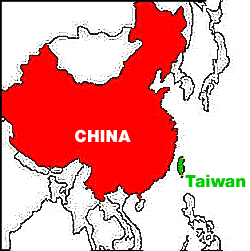 With Wushu becoming a part of international sports competition, it is essential that we establish a uniform terminology. Mr. Xu Cai, the former chairman of Preparation Committee for International Wushu Association, pointed out that it is totally understandable to Chinese people (who have long treasured the heritage of Wushu culture from their ancestors) to consider it Guoshu (national art) or Guoji (national technique). However, at this time as Wushu steps firmly onto the world stage, even becoming part of Olympic competition, we cannot limit it to the boundary of one single country. It is not Chinese Wushu; it is Wushu of the whole world. And it should be called, uniformly, just Wushu. There is a precedence for this situation. When Judo was listed as a formal competition entry in the 1964 Olympic Games, it was not preceded by the word Japanese. Still, everybody knows that the Japanese promoted and presented Judo to the world; furthermore, all the technical terms of Judo are in Japanese. During the International Wushu Festival held in Hangzhou, China in 1988, Mr. Xu Cai presented this opinion to the representatives of Asian Wushu Association from various countries and regions and got their consent. As Mr. Xu Cai pointed out at the time, though there have been historical reasons for various countries and regions to have different terms for Wushu, from the perspective of principles for field development and sports itself, the international Wushu movement should gradually have its terminology unified. Mr. Lin Jingyi, Chairman of Malaysian General Council of Guoshu, consented on the spot, and Mr. Li Jongcai, the Chairman of Singapore General Council of Guoshu, also seconded it. In less than one year, the general councils of Guoshu in both of these countries were changed to the general councils of Wushu.
With Wushu becoming a part of international sports competition, it is essential that we establish a uniform terminology. Mr. Xu Cai, the former chairman of Preparation Committee for International Wushu Association, pointed out that it is totally understandable to Chinese people (who have long treasured the heritage of Wushu culture from their ancestors) to consider it Guoshu (national art) or Guoji (national technique). However, at this time as Wushu steps firmly onto the world stage, even becoming part of Olympic competition, we cannot limit it to the boundary of one single country. It is not Chinese Wushu; it is Wushu of the whole world. And it should be called, uniformly, just Wushu. There is a precedence for this situation. When Judo was listed as a formal competition entry in the 1964 Olympic Games, it was not preceded by the word Japanese. Still, everybody knows that the Japanese promoted and presented Judo to the world; furthermore, all the technical terms of Judo are in Japanese. During the International Wushu Festival held in Hangzhou, China in 1988, Mr. Xu Cai presented this opinion to the representatives of Asian Wushu Association from various countries and regions and got their consent. As Mr. Xu Cai pointed out at the time, though there have been historical reasons for various countries and regions to have different terms for Wushu, from the perspective of principles for field development and sports itself, the international Wushu movement should gradually have its terminology unified. Mr. Lin Jingyi, Chairman of Malaysian General Council of Guoshu, consented on the spot, and Mr. Li Jongcai, the Chairman of Singapore General Council of Guoshu, also seconded it. In less than one year, the general councils of Guoshu in both of these countries were changed to the general councils of Wushu.
Kung fu, being very popular in the world in the last three decades, is another alternative name for Wushu. This word, most widely used in Europe, America and other continents, has become associated with threatening power all over the world. Whenever kung fu is mentioned, even some thugs feel somewhat scared. Kung fu, a word used by Taoists for their practice of breath channeling, was first brought to Europe by French missionaries returning from China about two hundred years ago. But it had never become popular in Europe, until the 1960s and 1970s when kung fu movies made by Chinese Wushu master Bruce Lee became popular among the general public. Kung fu itself is a word for Wushu commonly used in the areas of China's Guangdong (Canton) and Guangxi provinces. But, in China's history, it had never been used as a formal name for Wushu. When interpreted literally, kung fu means having skill, facility or ability. As an ancient Chinese saying goes, "As long as your kung fu is deep enough, even an iron rod can be ground into a needle." This is to inspire people that, no matter which job or career one is taking, as long as he/she is willing to make painstaking effort, there will always be some accomplishment. Of course, practicing Wushu is no exception. To really acquire kung fu (skill), a Wushu practitioner has to make painful effort in mastering basic techniques to build up a sound foundation and attain both Wushu's spirit and skill. Still, kung fu has never been a universal term. THE WAY OF WUSHU, a pictorial book written by two British authors in the 1990s, holds the same opinion. In its introduction to Chinese Wushu, the book claims: "In movies and publications, Wushu is often called kung fu. Strictly speaking, this is incorrect. Kung fu merely means practicing this technique with great frequency and effort. Actually, in China, this technique is called Wushu." Obviously, the deduction of these two British authors is quite in accordance with both reality and logic.
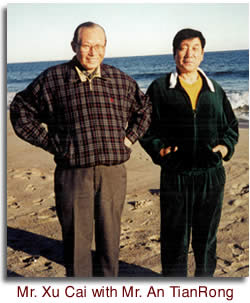 Currently, there is yet another general term for Wushu - martial art, used throughout the world. Quite a few translators translate Wushu to martial art. The accurate translation should always use the transliteration of Wushu. Martial art is an overall term for Wushu or Wuyi, including various fighting techniques, such as Judo, Karate, Tae Kwon Do, Akido, Tai Boxing and ancient European fighting techniques which, of course, also includes Chinese Wushu. In THE CONCISE ENCYCLOPEDIA BRITANNICA, translated and compiled by the Editing Division of Chinese Encyclopedia Publishing House in 1986, the Martial Art entry is translated as Wuyi, with the description of "various fighting techniques, mostly originated from the Far East, including Chinese Wushu and Judo, Karate and sword practice." Obviously, equating Wushu to martial art cannot accurately represent the unique system and historical development of Chinese Wushu.
Currently, there is yet another general term for Wushu - martial art, used throughout the world. Quite a few translators translate Wushu to martial art. The accurate translation should always use the transliteration of Wushu. Martial art is an overall term for Wushu or Wuyi, including various fighting techniques, such as Judo, Karate, Tae Kwon Do, Akido, Tai Boxing and ancient European fighting techniques which, of course, also includes Chinese Wushu. In THE CONCISE ENCYCLOPEDIA BRITANNICA, translated and compiled by the Editing Division of Chinese Encyclopedia Publishing House in 1986, the Martial Art entry is translated as Wuyi, with the description of "various fighting techniques, mostly originated from the Far East, including Chinese Wushu and Judo, Karate and sword practice." Obviously, equating Wushu to martial art cannot accurately represent the unique system and historical development of Chinese Wushu.
The term for a subject often cannot be separated from its historical, social and cultural contexts. Wushu originated, developed and expanded in China over several thousand years, and it is now enjoying further renovation and transformation in our time. Wushu now has a world appeal, and I sincerely hope that, along with the wide acceptance of the word Wushu, the technique and theory of Wushu will better serve the needs of people of all nationalities for their health improvement, meditation and self-defense.
About
An Tianrong :
![]() Written by An Tianrong for KUNGFUMAGAZINE.COM
Written by An Tianrong for KUNGFUMAGAZINE.COM
![]() Print Friendly Version of This Article
Print Friendly Version of This Article
